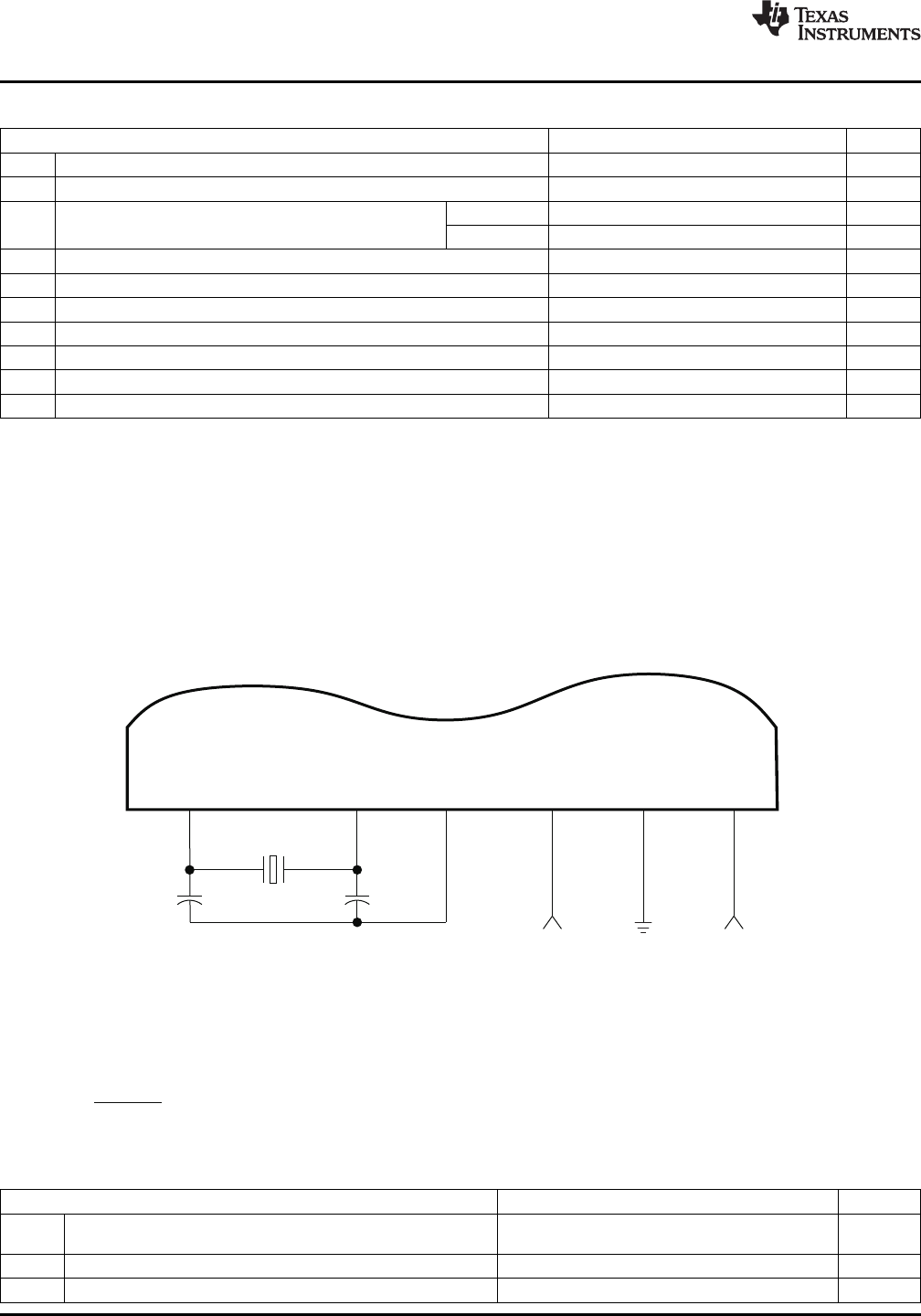Datasheet
Table Of Contents
- 1 Digital Media System-on-Chip (DMSoC)
- Table of Contents
- 2 Revision History
- 3 Device Overview
- 3.1 Device Characteristics
- 3.2 Device Compatibility
- 3.3 ARM Subsystem
- 3.3.1 ARM926EJ-S RISC CPU
- 3.3.2 CP15
- 3.3.3 MMU
- 3.3.4 Caches and Write Buffer
- 3.3.5 Tightly Coupled Memory (TCM)
- 3.3.6 Advanced High-Performance Bus (AHB)
- 3.3.7 Embedded Trace Macrocell (ETM) and Embedded Trace Buffer (ETB)
- 3.3.8 ARM Memory Mapping
- 3.3.9 Peripherals
- 3.3.10 PLL Controller (PLLC)
- 3.3.11 Power and Sleep Controller (PSC)
- 3.3.12 ARM Interrupt Controller (AINTC)
- 3.3.13 System Module
- 3.3.14 Power Management
- 3.4 DSP Subsystem
- 3.5 Memory Map Summary
- 3.6 Pin Assignments
- 3.7 Terminal Functions
- 3.8 Device Support
- 3.9 Documentation Support
- 3.10 Community Resources
- 4 Device Configurations
- 4.1 System Module Registers
- 4.2 Power Considerations
- 4.3 Clock Considerations
- 4.4 Boot Sequence
- 4.5 Configurations At Reset
- 4.6 Configurations After Reset
- 4.7 Multiplexed Pin Configurations
- 4.7.1 Pin Muxing Selection At Reset
- 4.7.2 Pin Muxing Selection After Reset
- 4.7.3 Pin Multiplexing Details
- 4.7.3.1 PCI, HPI, EMIFA, and ATA Pin Muxing
- 4.7.3.2 PWM Signal Muxing
- 4.7.3.3 TSIF0 Input Signal Muxing (Serial/Parallel)
- 4.7.3.4 TSIF0 Output Signal Muxing (Serial/Parallel)
- 4.7.3.5 TSIF1 Input Signal Muxing (Serial Only)
- 4.7.3.6 TSIF1 Output Signal Muxing (Serial Only)
- 4.7.3.7 CRGEN Signal Muxing
- 4.7.3.8 UART0 Pin Muxing
- 4.7.3.9 UART1 Pin Muxing
- 4.7.3.10 UART2 Pin Muxing
- 4.7.3.11 ARM/DSP Communications Interrupts
- 4.7.3.12 Emulation Control
- 4.8 Debugging Considerations
- 5 System Interconnect
- 6 Device Operating Conditions
- 7 Peripheral Information and Electrical Specifications
- 7.1 Parameter Information
- 7.2 Recommended Clock and Control Signal Transition Behavior
- 7.3 Power Supplies
- 7.4 External Clock Input From DEV_MXI/DEV_CLKIN and AUX_MXI/AUX_CLKIN Pins
- 7.5 Clock PLLs
- 7.6 Enhanced Direct Memory Access (EDMA3) Controller
- 7.7 Reset
- 7.8 Interrupts
- 7.9 External Memory Interface (EMIF)
- 7.10 DDR2 Memory Controller
- 7.10.1 DDR2 Memory Controller Electrical Data/Timing
- 7.10.2 DDR2 Interface
- 7.10.2.1 DDR2 Interface Schematic
- 7.10.2.2 Compatible JEDEC DDR2 Devices
- 7.10.2.3 PCB Stackup
- 7.10.2.4 Placement
- 7.10.2.5 DDR2 Keep Out Region
- 7.10.2.6 Bulk Bypass Capacitors
- 7.10.2.7 High-Speed Bypass Capacitors
- 7.10.2.8 Net Classes
- 7.10.2.9 DDR2 Signal Termination
- 7.10.2.10 VREF Routing
- 7.10.2.11 DDR2 CK and ADDR_CTRL Routing
- 7.11 Video Port Interface (VPIF)
- 7.12 Transport Stream Interface (TSIF)
- 7.13 Clock Recovery Generator (CRGEN)
- 7.14 Video Data Conversion Engine (VDCE)
- 7.15 Peripheral Component Interconnect (PCI)
- 7.16 Ethernet MAC (EMAC)
- 7.17 Management Data Input/Output (MDIO)
- 7.18 Host-Port Interface (HPI) Peripheral
- 7.19 USB 2.0 [see Note]
- 7.20 ATA Controller
- 7.21 VLYNQ
- 7.22 Multichannel Audio Serial Port (McASP0/1) Peripherals
- 7.23 Serial Peripheral Interface (SPI)
- 7.24 Universal Asynchronouse Receiver/Transmitter (UART)
- 7.25 Inter-Integrated Circuit (I2C)
- 7.26 Pulse Width Modulator (PWM)
- 7.27 Timers
- 7.28 General-Purpose Input/Output (GPIO)
- 7.29 IEEE 1149.1 JTAG
- 8 Mechanical Packaging and Orderable Information

( )
C C
1 2
C
L
C C
1 2
=
+
AUX_MXI/
AUX_CLKIN
AUX_MXO
C1 C2
Crystal
AUX_V
SS
24 MHz
1.8 V
AUX_DV
DD18
1.3 V
AUX_CV
DD
AUX_DV
SS
TMS320DM6467T
SPRS605C –JULY 2009–REVISED JUNE 2012
www.ti.com
Table 7-5. Input Requirements for Crystal on the 27 – 35-MHz System Oscillator
PARAMETER MIN NOM MAX UNIT
Start-Up Time (from power up until oscillating at stable frequency) 4 ms
Oscillation Frequency 27 33 or 33.3 35 MHz
27 – 31-MHz 50 Ω
ESR
32 – 35-MHz 40 Ω
Parallel Load Capacitance (C1 and C2) [Max] 12 – 20 pF
Frequency Tolerance ± 50 ppm
Aging ± 5 ppm
Thermal Stability ± 50 ppm
Oscillation Mode Fundamental n/a
Drive Level (Max) 0.8 mW
Shunt Capacitance (Max) 5 pF
7.4.1.2 24-MHz Auxiliary Oscillator Clock Input Option 1—Crystal
In this option, a crystal is used as the external clock input to the DM6467T auxiliary oscillator.
The 24-MHz oscillator provides the reference clock for USB and UART peripherals and the internal clock
source for the McASP peripherals. The on-chip oscillator requires an external 24-MHz crystal connected
across the AUX_MXI and AUX_MXO pins, along with two load capacitors, as shown in Figure 7-8. The
external crystal load capacitors must be connected only to the 24-MHz oscillator ground pin (AUX_V
SS
).
Do not connect to board ground (V
SS
). The AUX_DV
DD18
pin can be connected to the same 1.8 V power
supply as DV
DDR2
.
Figure 7-8. 24-MHz Auxiliary Oscillator
The load capacitors, C1 and C2, should be chosen such that the equation is satisfied (for typical values,
see Table 7-6). C
L
in the equation is the load specified by the crystal manufacturer. All discrete
components used to implement the oscillator circuit should be placed as close as possible to the
associated oscillator pins (AUX_MXI and AUX_MXO) and to the AUX_V
SS
pin.
Table 7-6. Input Requirements for Crystal on the 24-MHz Auxiliary Oscillator
PARAMETER MIN NOM MAX UNIT
Start-Up Time (from power up until oscillating at stable
4 ms
frequency of 24 MHz)
Oscillation Frequency 24 MHz
ESR 60 Ω
150 Peripheral Information and Electrical Specifications Copyright © 2009–2012, Texas Instruments Incorporated
Submit Documentation Feedback
Product Folder Link(s): TMS320DM6467T










